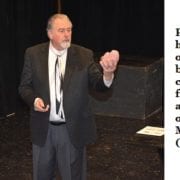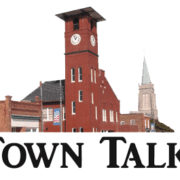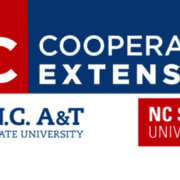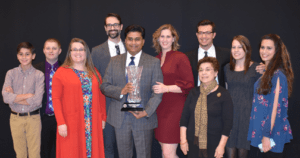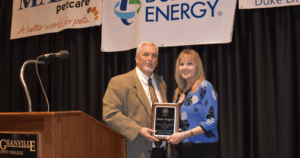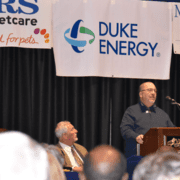— courtesy VGCC
Phil Dixon is passionate about the human brain, and he communicated his passion in a fascinating Jan. 30 discussion that kicked off a series of three lectures hosted by Vance-Granville Community College, entitled “Using Your Brain for a Change.”
Originally from England, Dixon has lived in Oxford, N.C., for less than a year. His work history has spanned many different industries and parts of the world, including a stint at Apple.
Today, though, Dixon spends much of his time reading the latest research about neuroscience and determining how that research can be translated into practical application in our daily lives. In particular, Dixon is deeply involved in the application of neuroscience to leadership and management issues.
He said the reason that he and others focus on the brain is simple. “Everything we think, do and dream starts right between your ears, so I think it’s pretty important to take a look at what’s going on there,” Dixon said. Beyond that, he recalled that, years ago, he noticed the abundance of books and articles being published by supposed experts on the subject of leadership. “And yet, with all that available, we didn’t seem to be producing any better leaders,” Dixon said. “In fact, we seemed to be producing leaders who were getting worse. I wondered why. I studied and realized that if we can better understand the brain, maybe we can be better leaders.”
Dixon began his interactive presentation by giving the audience an outline of the brain’s structure, which can be divided not only into two halves but also into three “layers.”
“The first layer, going from bottom to top, is what is sometimes called the ‘lizard brain,’ which is the activator for the fight-or-flight response,” Dixon explained. “It’s pretty much on autopilot. It keeps you breathing.” Second is the “mammalian brain” or the “limbic system.” “This layer is responsible for managing your emotions, memories, biases and habits, and is the activator of decision-making,” he said. “Finally there is the neocortex, which is responsible for those things we typically describe as what make us human: language, imagination, consciousness and reasoning.”
Dixon said that each of the brain’s approximately 86 billion neurons is connected to thousands of other neurons. “We used to think the brain looked like a computer, but now we think it looks more like the Internet, with everything connected to everything else,” he said. “Your brain continues to change, and make new connections, throughout your life. Its ‘neuroplasticity,’ its ability to change, is huge.”
The human brain is constantly “scanning” the environment, Dixon explained, picking up on cues that indicate potential threats and potential rewards. “Of all the ‘circuitry’ in the brain, we have five times as many circuits in the brain to pick up threats as we do to pick up rewards,” he said.
He described the brain’s reactions with the “Five P’s”: Protection, Participation, Prediction, Purpose and Pleasure. “What people want is to feel physically and emotionally safe, we want to feel part of the group, and to be able to predict or have control over our environment,” Dixon said. “If those are taken care of, we feel safe. Then, we are able to find out what our purpose is in life, and we can enjoy the pleasures of life.”
Dixon said he was “blown away” when he learned that researchers discovered that the brain treats an emotional threat in the exact same way as a physical threat. “If I diss or reject someone or shout at them, to the brain, it’s exactly the same as if I slapped them around,” he noted.
Chemically, Dixon said, when a human feels threatened, the brain releases cortisol, the so-called “stress hormone.” The bad news is that the cortisol “hangs around” in the brain for between two and five hours after the threat. “So in most work or learning environments, you really don’t want to put someone’s brain into a threat state if you can possibly avoid it, because cortisol practically shuts down someone’s ability to plan and organize, initiate and learn,” Dixon argued.
One thing that puts the brain into a “threat state,” he explained, is change. “We are in a “VUCA” environment today: volatility, uncertainty, complexity and ambiguity,” he said. “The brain likes to be able to predict things.”
Dixon’s series continues on Tuesday, Feb. 27, with “Your Brain on its Own,” focusing on how the brain operates when people are alone, including how they focus, make decisions and manage stress and time. The lecture is scheduled for 10:30 a.m. to noon, in the small auditorium in Building 2 on VGCC’s Main Campus in Vance County. The public is invited.
The series concludes with “Your Brain with Another Person” on Tuesday, March 27. Dixon’s lectures are presented by VGCC’s Office of the Endowment. For more information, call Endowment Director Eddie Ferguson at (252) 738-3264.
–VGCC–


